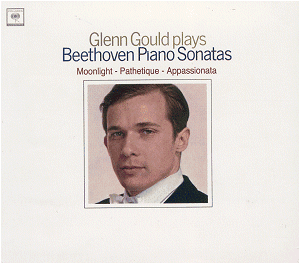Gould overwhelmingly favoured Beethovenís early works.
The corollary was his wholesale rejection of the essentially canonical
Beethoven, the visionary and metaphysical. Out went the Violin Concerto,
Appassionata, all the last Quartets, Symphonies 4, 5 and 6 (and
the last movement of the Ninth) and the Fifth Piano concerto. Surviving
the purge were Symphonies 2 and 8, the Op. 18 Quartets and Op. 95 and
amongst the piano sonatas, the Moonlight, The transgressive,
indomitably outrageous Gould reserves his greatest venom for the Appassionata,
which he berated for indulging the triumphalist. The Moonlight,
despite its popularity, appealed to him because it was "a masterpiece
of intuitive organization."
And yet what an unyielding performance the Moonlight
receives. At his unrelieved mezzo forte Gould is quick and cool in the
opening Adagio sostenuto and indulges in some point-scoring rhythmic
licence in the second, draining the line as he does so. In the finale
he is, despite his admiration for Beethovenís structural acuity, himself
less than persuasive when it comes to design. The Pathetique is
certainly not over-scrupulous when it comes to textual fidelity but
it is at least vigorous and dramatic with a slow movement of unsettled
and questing movement, sparked by disruptive left-hand accents. His
Appassionata is too well known for extensive comment but here
it is again in all its perverse glory. Funereal tempi, halting, hesitant,
fragmentary, this interminable Burlesque Beethoven sports an opening
movement lasting a quarter of an hour. Subverting "egoistic pomposity"
as Gould saw it is one thing but actively to disable momentum in the
Andante con moto, to impose a non-legato, lumpen nose thumbing triviality
is another.
Michael Stegemannís notes consider the dichotomous
heart of Gouldís relationship with Beethoven and also touch lightly
upon the complex issues of fidelity and imaginative recreation that
adhere to his performances of these and other sonatas.
Jonathan Woolf


